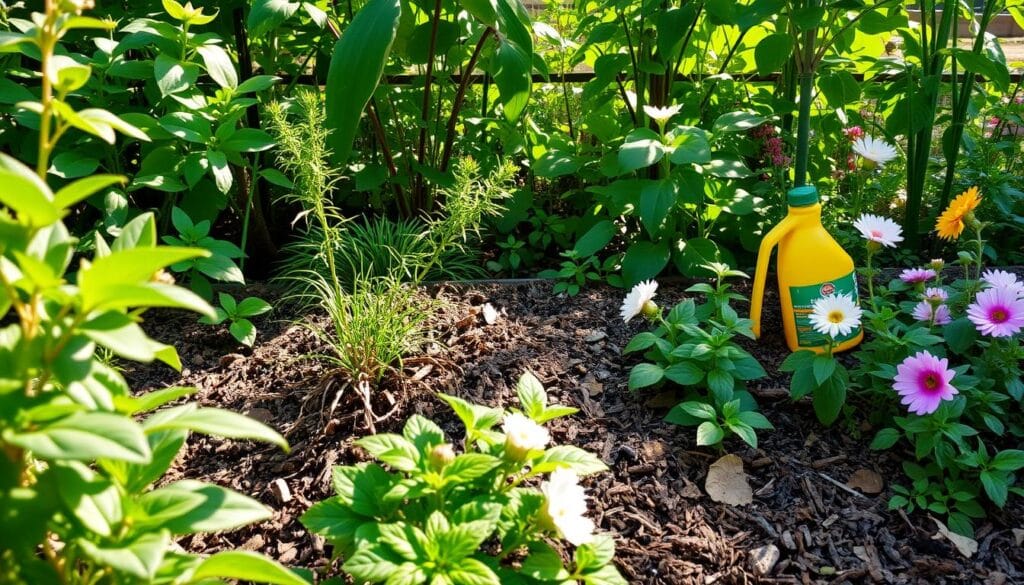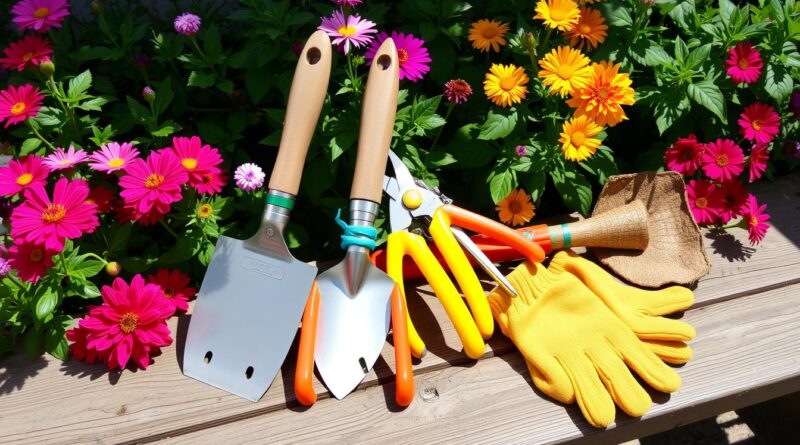Best Garden Maintenance Guide: Tips for Beginner Gardeners 2025
Starting a garden can seem overwhelming, especially for beginners. This guide aims to help you build a strong foundation. It covers everything from choosing the right tools to seasonal care. Follow these steps to create and keep a beautiful garden.
Table of Contents
Key Takeaways
- Discover the essential gardening tools and equipment needed to get started
- Learn how to properly prepare and maintain soil for optimal plant growth
- Explore effective watering techniques and irrigation systems
- Understand the importance of pruning and plant care methods
- Implement natural pest management solutions to keep your garden thriving
- Familiarize yourself with a seasonal garden maintenance calendar
- Gain the confidence to tackle all aspects of garden maintenance as a beginner
Getting Started: Essential Gardening Tools and Equipment
Starting your gardening journey is exciting. But, having the right tools is key to success. Whether you’re working on your lawn or growing veggies, the right tools matter. We’ll cover the basic hand tools, safety gear, and storage solutions to keep your garden tidy.
Basic Hand Tools for Every Gardener
As a beginner, start with the basics. A good hand trowel is essential for planting and soil work. Pruning shears help shape your plants, and a watering can keeps them hydrated. These tools are the backbone of any gardener’s collection.
- Hand trowel
- Pruning shears
- Watering can
Safety Equipment and Protective Gear
Gardening is fun, but safety comes first. Good gloves protect your hands from thorns and dirt. Knee pads and a wide-brimmed hat keep you comfortable and safe from the sun. With the right gear, you can garden safely and enjoy it more.
- Gardening gloves
- Knee pads
- Wide-brimmed hat
Storage Solutions for Garden Tools
Organizing your tools makes gardening more enjoyable. A tool shed or wall rack keeps things tidy. Portable bags or bins are great for carrying tools around. A good storage system means your tools are always ready and in good shape.
“The key to successful gardening is having the right tools for the job.”
The Ultimate Guide to Garden Maintenance for Beginners
Maintaining a garden is like an art that needs patience, knowledge, and a regular routine. For beginners, it can seem too much. This guide will give you the basics to keep your garden looking great all year.
Soil care is key to a healthy garden. First, learn about your soil’s pH and nutrients. Test your soil often and add the right stuff to make it perfect for your plants.
- Conduct soil tests to determine the pH and nutrient levels
- Add organic matter, such as compost or peat moss, to improve soil structure and fertility
- Adjust pH levels as needed to create an optimal environment for your plants
Watering right is also crucial. Make a watering plan that fits your plants’ needs. Think about the weather, plant type, and soil. Try water-saving methods like drip irrigation to help your garden and save water.
| Watering Frequency | Plant Type | Soil Condition |
|---|---|---|
| Daily | Vegetables, annuals | Sandy soil |
| 2-3 times per week | Perennials, shrubs | Loamy soil |
| Weekly | Trees, established plants | Clay soil |
Pruning and plant care are important for your garden’s health and look. Learn when and how to prune different plants. Keep your tools clean to stop diseases.
Dealing with weeds, pests, and diseases is also key. Use natural ways to control pests and weeds. Catch problems early to keep your garden healthy and beautiful.
“The glory of gardening: hands in the dirt, head in the sun, heart with nature. To nurture a garden is to feed not just the body, but the soul.” – Alfred Austin
With this guide, you’re ready to make your garden a lush oasis. Remember, gardening takes time and effort. Enjoy the journey and the rewards!
Understanding Soil Health and Preparation
Healthy soil is key for a great garden. Gardeners need to know how to keep the soil healthy. This means preparing and amending it for the best plant growth.
Soil Testing and pH Levels
Testing the soil’s pH is the first step. The pH level affects how well plants get nutrients. Most plants do best in a pH between 6.0 and 7.0. A simple test can show if your soil is too acidic or alkaline, helping you adjust it.
Soil Amendment Techniques
After knowing the pH, you can add organic matter like compost or manure. These improve the soil’s nutrient content and its ability to hold water. Composting is a great way to make this organic matter.
Creating the Perfect Growing Medium
- Blend the soil with compost or other organic matter to improve texture and drainage.
- Incorporate slow-release fertilizers to provide a steady supply of essential nutrients.
- Aerate the soil to improve oxygen levels and root growth.
- Adjust the pH as needed based on the specific requirements of the plants being grown.
By understanding and preparing the soil, gardeners can make a perfect growing medium. This ensures a healthy and abundant harvest.
| Soil Amendment | Benefits |
|---|---|
| Compost | Improves soil structure, increases water-holding capacity, and provides essential nutrients. |
| Manure | Adds organic matter and a wide range of nutrients to the soil. |
| Perlite | Enhances soil aeration and drainage, preventing waterlogging. |
| Lime | Raises soil pH, making nutrients more available for plants. |
“Healthy soil is the foundation for a thriving garden. By understanding and properly preparing the soil, gardeners can create the ideal growing conditions for their plants.”
Proper Watering Techniques and Irrigation Systems
Keeping a garden healthy needs careful watering. Beginner gardeners must learn how to water right. There are many ways to water your garden, from simple cans to complex systems.
Water your plants when it’s cooler, like in the morning or evening. This cuts down on evaporation and helps roots drink up the water. Also, adjust how often you water based on your area’s weather and soil.
Irrigation Systems for Your Garden
Irrigation systems make watering easier. They range from simple to complex. Drip irrigation is especially good because it waters plants right at the roots, saving water.
- Hose-end Sprinklers: These are easy to use and work well for small to medium gardens.
- In-ground Sprinkler Systems: These are buried and cover big areas well.
- Drip Irrigation: It waters plants at the base, saving water and being efficient.
Choosing the right irrigation system depends on water pressure, area, and plant needs. Learning to water right and using the right system helps your garden grow well.
| Irrigation System | Water Efficiency | Coverage Area | Maintenance |
|---|---|---|---|
| Hose-end Sprinklers | Moderate | Small to Medium | Low |
| In-ground Sprinkler Systems | High | Large | Moderate |
| Drip Irrigation | High | Targeted | Moderate |
“The key to a thriving garden is understanding the delicate balance between soil, sun, and water. Mastering the art of proper watering is a fundamental step towards gardening success.”
Essential Pruning and Plant Care Methods
Pruning is key to a healthy garden. It helps plants grow well and look great. Knowing how to prune is important for all types of plants.
Seasonal Pruning Guidelines
When you prune matters a lot. Prune in the plant’s dormant season, usually in late winter or early spring. This helps the plant heal and grow new shoots. But, some plants need pruning after they bloom to keep next year’s flowers intact.
Tool Sterilization and Maintenance
It’s important to keep pruning tools clean. Sterilize them with a disinfectant before and after use. Also, sharpen your tools to make clean cuts and avoid harming the plant.
Training Young Plants
Training young plants is crucial. It involves pruning to shape them right. This helps them grow strong and look good. Early training sets them up for success.
| Pruning Technique | Purpose | Best Timing |
|---|---|---|
| Thinning | Removes crowded, damaged, or undesirable branches to improve air circulation and light penetration. | Late winter or early spring |
| Heading Back | Shortens branches to encourage bushier growth and maintain a desired shape. | Late winter or early spring |
| Deadheading | Removes spent flowers to promote continued blooming and prevent seed production. | Throughout the growing season |
Learning to prune and care for plants can make your garden amazing. Using these pruning techniques will keep your garden healthy and beautiful for a long time.
Effective Weed Control Strategies
To keep your garden lush and weed-free, you need a solid plan. Weeds can take over and harm your plants if not stopped. We’ll look at ways to keep weeds out and help your garden grow strong.
Manual Weed Removal
One classic method is pulling weeds by hand or with a tool. It’s key to catch weeds early, before they spread. Make sure to pull out the whole weed, including the roots, to stop it from coming back.
Mulching for Weed Suppression
Using organic mulch around your plants can also help. Mulch keeps weed seeds from getting sunlight, stopping them from growing. It also keeps the soil moist, making it tough for weeds to survive. Good mulch options include bark chips, straw, or even newspapers.
Selective Herbicide Application
For tough weeds or hard spots, selective herbicides can work. These products target weeds without harming your plants. Always read the instructions and use herbicides carefully to protect your garden.
Keeping up with weed control is crucial for a healthy garden. By using a mix of pulling weeds, mulching, and herbicides, you can manage weeds and enjoy a beautiful garden.

“The key to successful weed control is to tackle the problem early and consistently. A little effort on a regular basis can save you a lot of time and frustration down the line.”
Natural Pest Management Solutions
Keeping your garden healthy and pest-free is crucial for garden lovers. Chemical pesticides might seem easy, but organic methods are better for the planet. We’ll look at common pests, how to control them organically, and ways to prevent problems.
Common Garden Pests Identification
Spotting pests is the first step to fighting them. Aphids, spider mites, caterpillars, and slugs are common pests. Look for signs like chewed leaves or discolored plants to catch issues early.
Organic Pest Control Methods
- Companion planting: Plants like marigolds and basil can keep pests away.
- Biological control: Natural predators like ladybugs and lacewings can control pest numbers.
- Organic pesticides: Natural products like neem oil or diatomaceous earth can manage pests safely.
Preventive Measures
Keeping your garden healthy is key to avoiding pests. Regularly check your plants, clean up debris, and ensure plants have enough space and drainage. This helps prevent pests from taking over.
| Common Garden Pests | Organic Control Methods | Preventive Measures |
|---|---|---|
| Aphids | Ladybugs, neem oil | Proper plant spacing, remove weeds |
| Spider Mites | Predatory mites, horticultural oil | Maintain plant health, avoid overwatering |
| Caterpillars | Bacillus thuringiensis (Bt), handpicking | Use floating row covers, remove egg clusters |
| Slugs | Beer traps, diatomaceous earth | Maintain good drainage, remove hiding spots |
Using natural pest control methods can make your garden pest-free and healthy. It also helps the environment. A balanced approach is essential for pest management and keeping your gardening tips beautiful.
Seasonal Garden Maintenance Calendar
Keeping a garden healthy all year needs careful planning. This guide helps beginners keep their garden looking great. It covers what to do each season to keep your garden thriving.
In early spring, start by enriching the soil with organic matter. Test the soil to adjust its pH levels. Prune plants that are still dormant, clear out winter debris, and plant cool-weather crops like lettuce and peas.
As spring warms up, introduce warm-weather plants. Make sure to water regularly. This keeps your garden healthy and green.
Summer brings the need to fight weeds and pests. Regularly remove weeds and check for pests. Keep watering deeply to help plants grow well. In autumn, focus on lawn care and planting for the next season. Mulch and protect plants from cold weather.
FAQ
What are the essential gardening tools and equipment every beginner should have?
Beginners need a hand trowel, pruning shears, and gardening gloves. A watering can and garden hose are also key. Don’t forget safety gear like knee pads and a wide-brimmed hat.
How do I test and improve the health of my garden soil?
Testing your soil is the first step. You can buy a kit or get a professional analysis from your local extension office. Based on the results, add compost or aged manure to improve your soil.
What are the best techniques for watering my garden effectively?
Water deeply but infrequently. This helps your plants’ roots grow strong. Water in the morning or evening to reduce evaporation. Consider using an irrigation system or soaker hose for efficient watering.
How do I properly prune and care for my plants?
Prune in the dormant season to promote growth. Use sharp tools and sterilize them to prevent disease. Guide young plants gently and use supports when needed.
What are some effective strategies for controlling weeds in my garden?
Start by preventing weeds with mulch. Pull weeds regularly before they spread. For tough weeds, use selective herbicides carefully.
How can I naturally manage pests in my garden?
Use natural methods to control pests. Introduce beneficial insects and use companion planting. Apply horticultural oils or insecticidal soaps as needed. Keep your plants healthy and diverse to prevent pests.
What should I do to prepare my garden for each season?
Keep a seasonal garden calendar. In spring, prepare the soil and plant. Summer is for watering and pest control. Fall is for pruning and mulching. Winter is for maintenance and planning.

